Dental crowns and bridges are two forms of dentistry used to repair damaged teeth or replace teeth lost secondary to caries, trauma, periodontal disease, etc. For patients, regaining function and improving aesthetics are often important criteria for dental implant treatment. Throughout the last fifty years, materials used for dental implants have been extensively researched, and an understanding of how the physical and chemical properties affect clinical outcomes of treatment has considerably improved.
These properties include the surface composition and microstructure of dental implants. Ideally, implant materials should be biocompatible and resistant to corrosion and fracture. Implants can be made from titanium or zirconia (ceramic).
At DDS Lab, the material we recommend for crown and abutment restorations will depend on several factors, including which tooth is being replaced, the presence or absence of parafunctional habits, and metal allergies. Before choosing the material for crowns or fixed prostheses, it is essential to discuss the benefits and limitations of each option.
Restorative dentists who do not place implants need to know the following points regarding the implants that they will be restoring:
- Implant manufacturer (Straumann, ZimVie, Nobel Biocare, MIS, BioHorizons, and Dentsply).
- Implant/abutment connection.
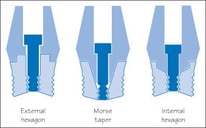
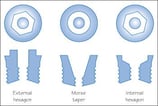
- Diameter of the implant/abutment connection.
- Screwdrivers needed to remove and insert the specific implant restorative components.

- Insertion torque value recommended for screws.
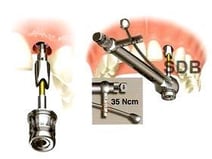

Abutment Types for Dental Implants
Abutments are implant restorative components screwed directly into dental implants.
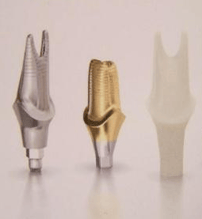
Image: Abutments made from titanium, titanium with gold titanium nitride, and zirconia (left to right).
They include:
Custom Designed (CAD/CAM) Abutments and Crowns
They may be machined from many materials, including titanium, zirconia, base metal, PMMA, high-performance polymers (HPP), and composite resins. Definitive abutments are typically manufactured from titanium, zirconia, or base metals. They may be used for cement- and screw-retained restorations.
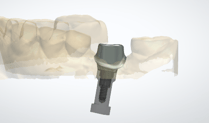
Image: Computer design of a titanium abutment for use with a cement-retained crown.|
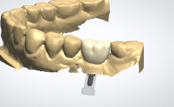
Image: A digitally designed zirconia crown on the CAD-designed titanium abutment above.

Image: CAD/CAM zirconia abutments.
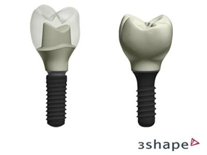
Image: Cement-retained zirconia crown and CAD/CAM zirconia abutment.
Stock Abutments
Stock abutments may be fabricated with materials similar to custom abutments. They are available in multiple shapes, angles, and margin collar heights. They are generally less expensive than custom abutments.
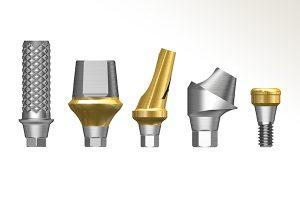
Image: Stock Abutments
Porcelain Fused-to-Metal (PFM) Dental Implant-Supported Restorations

Image: Custom or stock abutments may be used for cement-retained restorations such as PFM crowns.

Image: PFM crown in place on die (digital workflow).
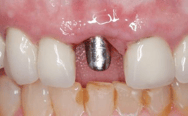
Image: Titanium abutment in place. This abutment replicated the plastic die in the above image.
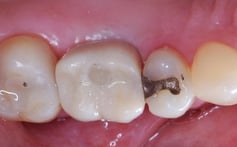
Image: PFM crowns can also be used for screw-retained crowns.
As the name suggests, porcelain fused to metal (PFM) crowns combine porcelain and metal. The porcelain overlay is color-matched to the patient’s natural teeth. Sometimes, the dark metal margin could show at the gingival margin, especially with gingival recession or high smile lines. Dentists may recommend PFM restorations for patients who desire strength and a natural appearance.
Benefits of PFM restorations
- The material is durable.
- Matching a patient’s tooth coloring to PFM restorations may be relatively easy.
Limitations of PFM restorations
- PFM restorations contain various types of metals, which can cause allergic reactions in some patients.
- The metal around the margins of PFM crowns can become visible at the gingival margin, which is considered unappealing for some patients.
Zirconia Dental Implant-Supported Restorations
Zirconia restorations are ceramic-type restorations; they are not metal. They may fracture more easily than PFM crowns. Zirconia, a metal in the periodic table of elements, is found worldwide. Everyday household items such as dinnerware, pipes, and electrical fixtures are made from zirconia.
Because of its natural strength and durability, zirconia may be used with excellent results for dental crowns. Zirconia crowns are best for patients who need posterior crowns, which require greater strength for masticating food and parafunctional habits. They are generally more opaque than feldspathic porcelains or lithium disilicate restorations.
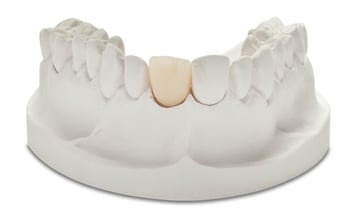
Image: Zirconia Crown
Benefits of Zirconia
- Compatible with human tissues.
- Restorations have a low bacterial attraction.
- High strength and reasonable fracture resistance.
- Minimal wear and corrosion.
- Excellent esthetics (no metal margins).
Limitations of Zirconia
- Over time, the material may deteriorate and lead to microfractures.
- Grinding zirconia can decrease its fracture resistance. Polishing is possible with select kits available from multiple manufacturers.
- Zirconia crowns can be more costly.
The skilled technicians at DDS Lab have in-depth knowledge about zirconia, titanium, and PFM materials used for restorations and are always willing to discuss specific cases with you.
Click here to schedule a consultation with our technical team ›
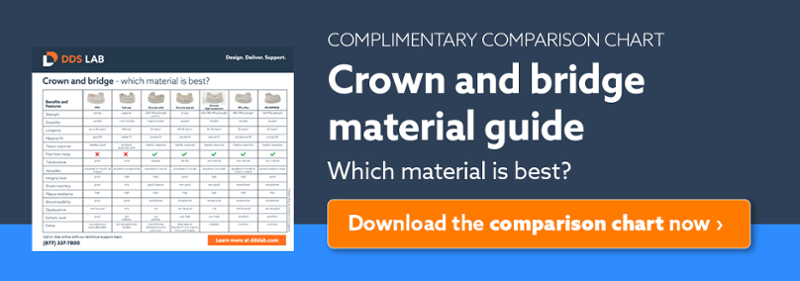
References:
https://www.solarisdentaldesign.com/why-patients-should-choose-all-ceramic-restorations-instead-of-pfm-porcelain-fused-to-metal/
https://blog.ddslab.com/pfm-vs-zirconia-which-material-is-better
https://blog.ddslab.com/zirconia-vs-titanium-dental-implants
https://www.colgate.com/en-us/oral-health/implants/zirconia-vs-titanium-implants-which-one-is-right-for-you
https://pubmed.ncbi.nlm.nih.gov/10356553/
https://titanium-gateway.com/vanliga-fragor/what-is-alloyed-titanium/